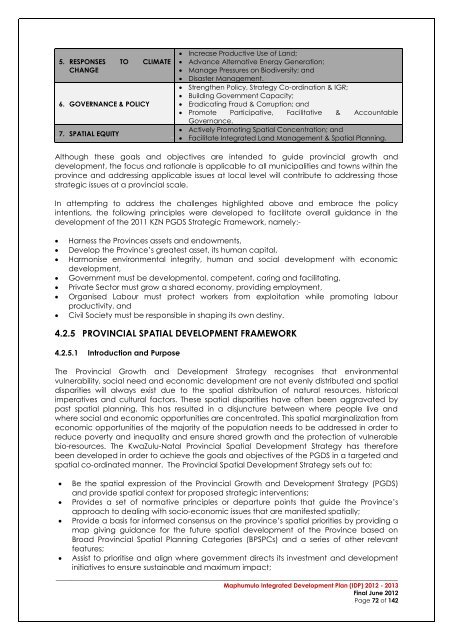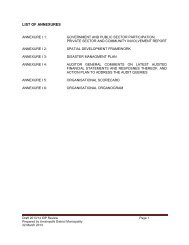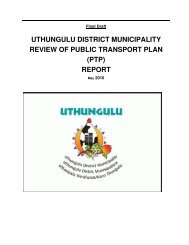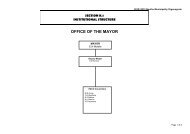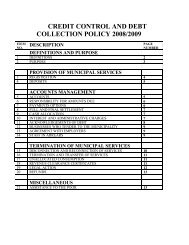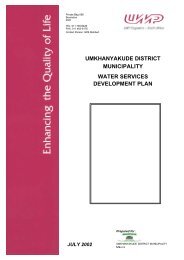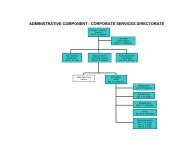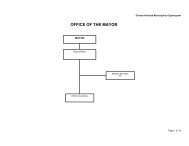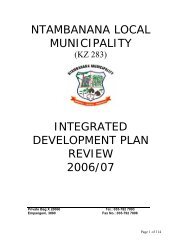Maphumulo IDP - KZN Development Planning
Maphumulo IDP - KZN Development Planning
Maphumulo IDP - KZN Development Planning
You also want an ePaper? Increase the reach of your titles
YUMPU automatically turns print PDFs into web optimized ePapers that Google loves.
5. RESPONSES TO CLIMATECHANGE6. GOVERNANCE & POLICY7. SPATIAL EQUITY Increase Productive Use of Land; Advance Alternative Energy Generation; Manage Pressures on Biodiversity; and Disaster Management. Strengthen Policy, Strategy Co-ordination & IGR; Building Government Capacity; Eradicating Fraud & Corruption; and Promote Participative, Facilitative & AccountableGovernance. Actively Promoting Spatial Concentration; and Facilitate Integrated Land Management & Spatial <strong>Planning</strong>.Although these goals and objectives are intended to guide provincial growth anddevelopment, the focus and rationale is applicable to all municipalities and towns within theprovince and addressing applicable issues at local level will contribute to addressing thosestrategic issues at a provincial scale.In attempting to address the challenges highlighted above and embrace the policyintentions, the following principles were developed to facilitate overall guidance in thedevelopment of the 2011 <strong>KZN</strong> PGDS Strategic Framework, namely:-Harness the Provinces assets and endowments,Develop the Province’s greatest asset, its human capital,Harmonise environmental integrity, human and social development with economicdevelopment,Government must be developmental, competent, caring and facilitating,Private Sector must grow a shared economy, providing employment,Organised Labour must protect workers from exploitation while promoting labourproductivity, andCivil Society must be responsible in shaping its own destiny.4.2.5 PROVINCIAL SPATIAL DEVELOPMENT FRAMEWORK4.2.5.1 Introduction and PurposeThe Provincial Growth and <strong>Development</strong> Strategy recognises that environmentalvulnerability, social need and economic development are not evenly distributed and spatialdisparities will always exist due to the spatial distribution of natural resources, historicalimperatives and cultural factors. These spatial disparities have often been aggravated bypast spatial planning. This has resulted in a disjuncture between where people live andwhere social and economic opportunities are concentrated. This spatial marginalization fromeconomic opportunities of the majority of the population needs to be addressed in order toreduce poverty and inequality and ensure shared growth and the protection of vulnerablebio-resources. The KwaZulu-Natal Provincial Spatial <strong>Development</strong> Strategy has thereforebeen developed in order to achieve the goals and objectives of the PGDS in a targeted andspatial co-ordinated manner. The Provincial Spatial <strong>Development</strong> Strategy sets out to: Be the spatial expression of the Provincial Growth and <strong>Development</strong> Strategy (PGDS)and provide spatial context for proposed strategic interventions; Provides a set of normative principles or departure points that guide the Province’sapproach to dealing with socio-economic issues that are manifested spatially; Provide a basis for informed consensus on the province’s spatial priorities by providing amap giving guidance for the future spatial development of the Province based onBroad Provincial Spatial <strong>Planning</strong> Categories (BPSPCs) and a series of other relevantfeatures; Assist to prioritise and align where government directs its investment and developmentinitiatives to ensure sustainable and maximum impact;__________________________________________________________________________________________<strong>Maphumulo</strong> Integrated <strong>Development</strong> Plan (<strong>IDP</strong>) 2012 - 2013Final June 2012Page 72 of 142


